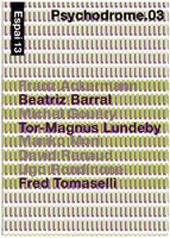- Exhibition program
- Cycle: Psychodrome
- Author
- Beatriz Barral, Tor-Magnus Lundeby i Fred Tomaselli
- Dates
- —
- Curated by
- Grazia Quaroni i David Renaud
After hypnosis and vision, synaesthesia is the fundamental component of this third phase of “Psychodrome”.
Synaesthesia is the capacity of any one of the senses to arouse a different sense, an ambiguous game that confuses our instruments of perception, allowing us to feel colours, see sounds, and taste forms. The three artists taking part in “Psychodrome.03” are specialists in the ambiguity of perception, in the informal use of methodologies of exceptional precision, and in the global pictorial experience, obtained by the use of unusual supports, non-pictorial materials and a large expanse of wall surfaces.
As Lars Bang Larsen says of Tor-Magnus Lundeby, “The psychedelic lore is not employed as a retro gesture, but as an artistic method for mapping the self and stimulating the experience of the now.” This can also be applied to Fred Tomaselli and Beatriz Barral, who share the exhibition area with Lundeby: the psychedelic component, the element that disorders each person’s vision, consciousness and system of perception, never employed in a nostalgic way but as an experience of the present, not as decoration but as a system based on the artist’s consciousness and senses in order to expand in space to reach the viewers’ senses and consciousness, giving them complete freedom to experience the work and the space in an entirely personal way. These works are not therefore tricks of perception but free, open spaces in which to move around.
Beatriz Barral (Madrid, 1968, living in Madrid and New York). Her fluorescent capsules envelope the viewer, altering their colour, skin, eyes and clothes. Like other artists in the Psychodrome cycle, her work is dominated by round forms which bend the walls, deform the space and disorientate the viewer, with a touch of science fiction in both the forms and the matter. Barral unleashes the potential of colour in all its magnitude, and with this treatment gets the maximum performance from the space and from the architecture. The overstated colours and matter are not easy on the eye, and this is precisely the artist’s aim: to play with perception, to explore visual sensations and impressions on the retina in order to disconcert the viewer’s consciousness. This is essential in order to “establish the parameters of a better future”. And so she is able to say, “My vision can be described as utopian”.
Tor-Magnus Lundeby (Norway, 1966, living in Helsinki, Finland). The themes of Lundeby’s pictorial installations find their inspiration in the most varied places. From video games to astronomy, from record sleeves to maps, any pretext is valid for constructing a new universe, a fantasy cosmology. The visitor’s eye is overwhelmed by the huge dimensions and the exasperating repetition of motifs. His installations often relate to the world of music - DJs, 45 rpm records, the so-called “club culture”. Names of famous and not so famous musicians of all genres and nationalities follow each other on the painted walls and constitute the archives of imaginary or existing independent radio stations: the names are satellites, busy worker bees, that are in the air, “on air”, around the queen bee, the transmitter, the soul and prop of the whole thing.
Fred Tomaselli (USA, 1956, living in New York) makes pictures without painting. His motifs of whirlpools and galaxies, impregnated with literary references, offer a new kind of universe, a distorted utopia that disconcerts the spectator. His works are collages that, observed from a distance, enable us to capture the cosmic, visionary effect and, seen close up, reveal the minute details of the system and the variety of materials, which are not always licit or legal. Close to, we discover what produces these visions filled with images that we had savoured from a distance: pills, leaves, insects, aspirins and a mass of minute objects of different kinds are encased in resin and arranged with the utmost precision to form a perfectly smooth surface. By showing the substances that can induce hallucinations together with a visionary overall image, Tomaselli manages to present cause and effect in a perfect circle – the before and after simultaneously – distorting time and space in infinite declinations.
Grazia Quaroni
February 2003








